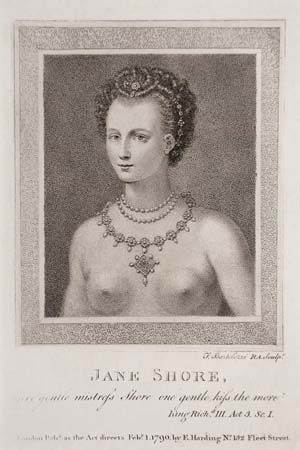
Francesco Bartolozzi RA (1727-1815)
Bartolozzi, the son of a goldsmith, was born at Florence. He studied drawing under Giovanni Domenico Ferretti (1692-1768) there and was taught engraving by Joseph Wagner (1706-1780) in Venice.
He arrived in England in 1764, where he replaced Sir Robert Strange as engraver to King George III. According to Redgrave, ‘His skill in drawing the figure and knowledge of the principles of painting were unequalled, and on the establishment of the Royal Academy in 1768, he was nominated a member. As an engraver, he was a complete master of his art, and the diploma of the Royal Academy, engraved by him, is unrivalled…’
In 1802, Bartolozzi was appointed Director of the National Academy in Lisbon, Portugal.
Basil Gray states that, ‘Another process used in the reproduction of drawings was the crayon manner, in which the line is worked on the prepared plate with a roulette [a textured rotating wheel on the end of a short handle] without the intervention of any paper. Both this and stipple, in which a similar dotting and flicking with roulette or etching needle produces a tone, were introduced into England by Francesco Bartolozzi, who worked in England between 1764 and 1802 and produced with his pupils a great mass of prints after Guercino, Holbein and living artists like Cipriani and Angelica Kauffmann. These are clean, light and graceful…’
Collections
British Museum, London
Metropolitan Museum, New York
National Gallery of Ireland, Dublin
National Portrait Gallery, London
Royal Collection Trust
Tate Gallery, London
Victoria and Albert Museum, London
Literature
Gray, B (1937), The English Print, Adam and Charles Black
Hind, A M (1963 reprint), A History of Engraving and Etching, Dover Publications
Mackenzie, I (1988), British Prints, Antique Collectors’ Club
Redgrave, S (1970 reprint), A Dictionary of Artists of the English School, Kingsmead Reprints
Williamson, G C Ed. (1904), Bryan’s Dictionary of Painters and Engravers, George Bell and Sons
Bartolozzi, the son of a goldsmith, was born at Florence. He studied drawing under Giovanni Domenico Ferretti (1692-1768) there and was taught engraving by Joseph Wagner (1706-1780) in Venice.
He arrived in England in 1764, where he replaced Sir Robert Strange as engraver to King George III. According to Redgrave, ‘His skill in drawing the figure and knowledge of the principles of painting were unequalled, and on the establishment of the Royal Academy in 1768, he was nominated a member. As an engraver, he was a complete master of his art, and the diploma of the Royal Academy, engraved by him, is unrivalled…’
In 1802, Bartolozzi was appointed Director of the National Academy in Lisbon, Portugal.
Basil Gray states that, ‘Another process used in the reproduction of drawings was the crayon manner, in which the line is worked on the prepared plate with a roulette [a textured rotating wheel on the end of a short handle] without the intervention of any paper. Both this and stipple, in which a similar dotting and flicking with roulette or etching needle produces a tone, were introduced into England by Francesco Bartolozzi, who worked in England between 1764 and 1802 and produced with his pupils a great mass of prints after Guercino, Holbein and living artists like Cipriani and Angelica Kauffmann. These are clean, light and graceful…’
Collections
British Museum, London
Metropolitan Museum, New York
National Gallery of Ireland, Dublin
National Portrait Gallery, London
Royal Collection Trust
Tate Gallery, London
Victoria and Albert Museum, London
Literature
Gray, B (1937), The English Print, Adam and Charles Black
Hind, A M (1963 reprint), A History of Engraving and Etching, Dover Publications
Mackenzie, I (1988), British Prints, Antique Collectors’ Club
Redgrave, S (1970 reprint), A Dictionary of Artists of the English School, Kingsmead Reprints
Williamson, G C Ed. (1904), Bryan’s Dictionary of Painters and Engravers, George Bell and Sons
Our full selection of antique prints can be viewed here.